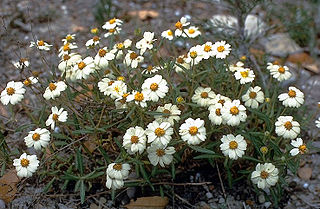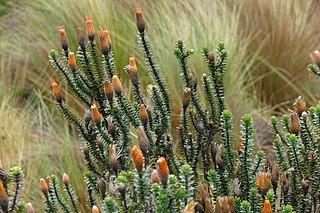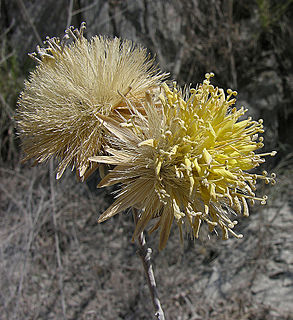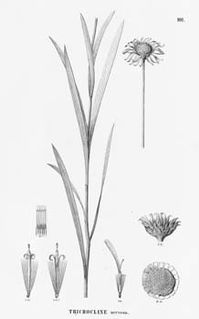
Melampodium is a genus of flowering plants in the sunflower family.

Chuquiraga is a genus of flowering plants in the family Asteraceae. The genus is distributed in the Andes from Colombia to Chile, with most species occurring in Patagonia.

The Mutisioideae are a subfamily in the plant family Asteraceae that includes about 630 species assigned to 44 different genera. This subfamily is mainly native in South America, except for Adenocaulon, Chaptalia, Gerbera, Trichocline, which have species in all continents other than Europe and Antarctica. Common characters are the deeply incised corollas of the disc florets, with five lobes, sometimes merged in two lips, flower heads with overlapping involucral bracts, anthers with tails and pointy tips, the styles usually stick far out of the florets and are essentially hairless. Most species are herbs, but some are vines, shrubs, or small trees.
Boeberoides is a monotypic genus of flowering plants in the family Asteraceae. It contains only one known species, Boeberoides grandiflora. It is endemic to Mexico.

Dinoseris is a monotypic genus of flowering plants in the family Asteraceae, containing the single species Dinoseris salicifolia. It is native to Bolivia and Argentina. It was formerly included in genus Hyaloseris.
Huarpea is a genus of flowering plants in the family Asteraceae.

Lulia is a genus of Brazilian flowering plants in the family Asteraceae.
Novenia is a genus of flowering plants in the tribe Astereae within the family Asteraceae. It is monotypic, being represented by the single species Novenia tunariensis, which is native to Argentina (Salta) and Peru.
Perdicium is a genus of African plants in the tribe Mutisieae within the family Asteraceae.

Perezia is a genus of flowering plants in the family Asteraceae. It is distributed in South America, especially in the central and southern Andes.
Bishopanthus is a monotypic genus of flowering plants in the aster family, Asteraceae, containing the single species Bishopanthus soliceps. It is endemic to Peru.
Cabreriella is a genus of flowering plants in the aster family, Asteraceae. It is native to South America.

Catamixis is a genus assigned to the family Asteraceae, with only one known species, Catamixis baccharoides, a low to medium height, ¾—1¾ m, shrub. It is native to a very small area of western Nepal and northern India in the Himalayas. It has approximately spoon-shaped, leathery leaves with distanced rounded teeth alternately set along straight, shyly branching stems, and carries many flower heads of about 1 cm, with a few creamy white florets, sometimes with a hint of violet, in corymbs at the end of the branches. Flowers and fruits can be found between March and May. Its vernacular name in Hindi is विषपत्री (vishpatri) or विश्पत्र (vishpatra).
Chionopappus is a monotypic genus of flowering plants in the aster family, Asteraceae, containing the single species Chionopappus benthamii. It is endemic to Peru, where it occurs at elevations up to 2500 meters in the central part of the country. It is also sometimes found in the lomas of northern Peru, a type of moist oasis formed by fog that accumulates along the hills in the coastal desert region.
Chucoa is a genus of South American flowering plants in the family Asteraceae.

Cyclolepis is a monotypic genus of flowering plants in the family Asteraceae. The sole species, Cyclolepis genistoides, is native to South America, where it occurs in Argentina, Chile, Paraguay, and possibly Bolivia. Its common names include matorro negro.
Aylacophora is a genus of flowering plants in the family Asteraceae.

Gamochaeta is a genus of flowering plants in the family Asteraceae. There has not always been agreement among botanists regarding its status as a recognized genus, but it has become more accepted in recent years. It currently includes many plants that previously belonged in genus Gnaphalium. Like many species of Gnaphalium, many Gamochaeta are called cudweeds or everlastings.
Criscia is a genus of South American flowering plants in the family Asteraceae.

The Nassauvieae are a tribe of flowering plants in the family Asteraceae.









